Japan
Wood Products Prices
Dollar Exchange Rates of 10th
Oct
2022
Japan Yen 145.7
Reports From Japan
BoJ quarterly
report surprisingly optimistic
A Bank of Japan (BoJ) quarterly report found that most of
Japan’s regional economies are picking up ‘moderately’
with some firms considering raising wages. This is
essential if household incomes can grow to compensate for
rising living costs. The BoJ raised its assessment for one
of the country’s nine regions and left its view unchanged
for the remaining eight.
A private research firm, Teikoku Databan, has reported
that prices of about 6,700 food and beverage products will
rise in October as manufacturers are faced with rising
material costs and a weaker yen.
The firm says prices of 20,665 items have been or will be
raised this year including those that have been raised
multiple times. The average increase is 14%. October will
be the peak month for price increases this year but with
rising prices of electricity, gas and food periodic waves of
price increases could occur in 2023 and onwards.
See:
https://www.boj.or.jp/en/research/brp/rer/data/rer221006.pdf
and
https://www3.nhk.or.jp/nhkworld/en/news/20221002_08/
Forecast that inflation will be short lived questioned
Core consumer prices in Tokyo, a leading indicator of
nationwide inflation, rose 2.8% year on year in September,
exceeding the BoJ's 2% target for a fourth straight month.
The data reinforced market expectations that nationwide
core consumer inflation will approach 3% in the coming
months and may cast doubt on the BoJ view that recent
cost-push price increases will prove temporary.
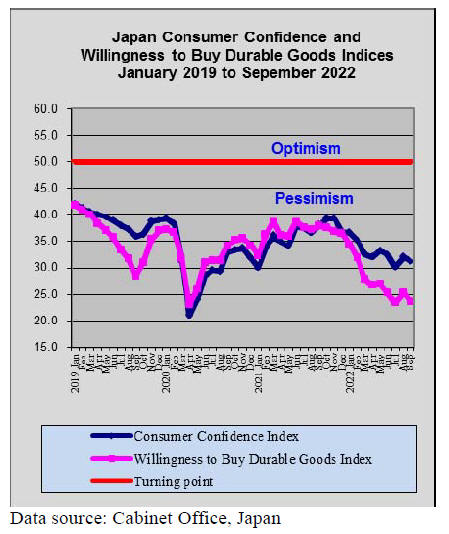
The Prime Minister has urged companies to aim for
pay
increases that keep pace with inflation during wage
negotiations next spring. The government aims to expand
subsidies for small and medium sized companies on
condition that they raise pay. The Russian invasion of
Ukraine has pushed up energy, raw material and grain
prices which have driven inflation.
Machinery orders – a major decline
Machinery orders placed with major manufacturers (an
indicator of corporate sentiment) marked the biggest
single-month fall in six months in August due to the global
economic slowdown and a sharply weaker yen that pushed
up import costs. This does not bode well for corporate
spending.
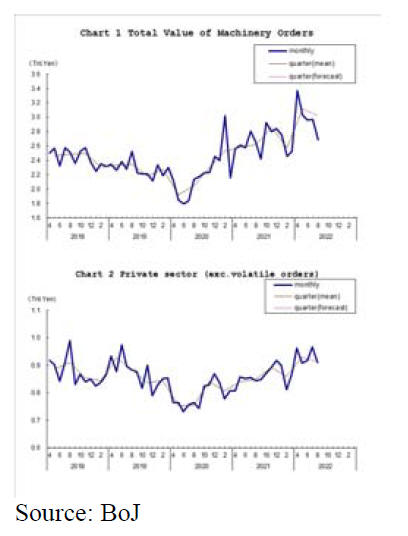
The total value of machinery orders received by 280
manufacturers operating in Japan fell by 9.5% in August
from the previous month on a seasonally adjusted basis.
Private-sector machinery orders, excluding volatile ones
for ships and those from electric power companies,
decreased a seasonally adjusted by 5.8% in August.
See:
https://www.esri.cao.go.jp/en/stat/juchu/2022/2208juchue.html
Bankruptcies rise
The number of private sector bankruptcies in Japan rose
6.9% year on year between April and September, the first
increase in three years. The biggest challenge, it seems, is
that companies are having a hard time repaying the loans
they received from the government in response to the
COVID-19 pandemic.
Yen titling to 150 to the dollar
Throughout Asia currencies are falling to record lows not
seen since the 1997 financial crisis. These changes have
unnerved businesses and policymakers who remember
how depreciation caused a collapse of Asian currencies.
To minimise the risk of a repeat policymakers and central
banks are trying to stabilise their currencies. The State
Bank of Vietnam raised interest rates last month as the
dong had fallen for nine straight days to a 29-year low.
The same day Vietnam raised interest rates, Japan, where
the yen has dropped around 25% against the dollar this
year, intervened in an attempt to strengthen its
currency for the first time since 1998.
In China, where the renminbi is trading near 14-year lows,
the central bank has taken a series of measures to slow the
currency’s depreciation.
The yen touched a low of 148.86 versus the dollar Friday,
the weakest level since August 1990, before ending the
session at 148.67.
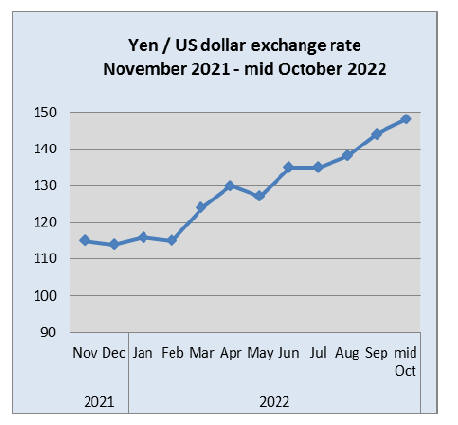
The real estate sector in Japan is enjoying a boom
at
present as the weak yen and foreign interest in the
Japanese housing market has come together to drive
demand.
With a yen that has fallen 25% against the US dollar,
Japan’s traditional attraction for foreign real estate
investors could grow.
House prices in urban areas are getting close to the highs
seen 25 years ago. Japan hasn’t enjoyed its current rates of
growth since prices began to inflate in the 1980s. But
questions remain, could this lead to another housing
bubble?
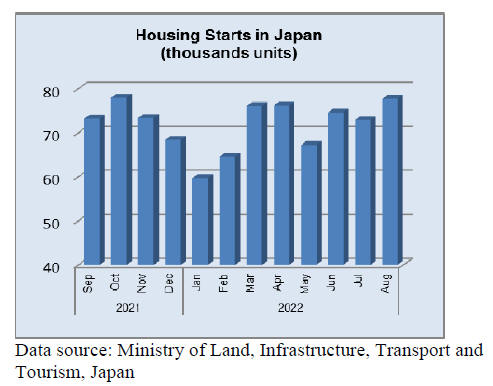
Furniture imports
After three consecutive months of increasesthere was a
correction in the value of wooden bedroom furniture
imports in July. The value of July wooden kitchen
furniture imports added to the gains made in June but, the
value of wooden office furniture imports was flat.
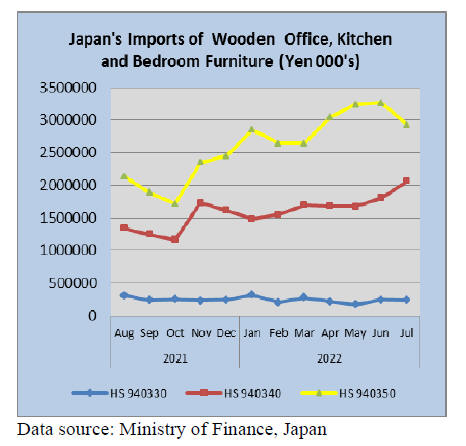
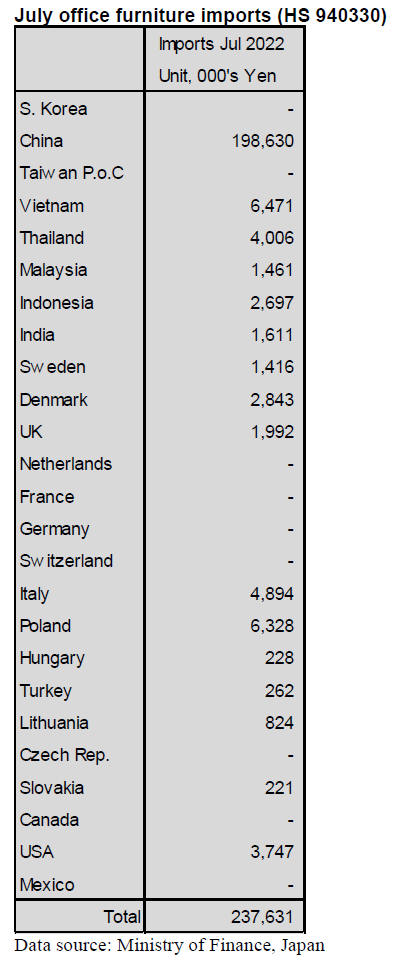
In July the value of shipments of wooden office
furniture
(HS940330) from China accounted for over 80% of all
wooden office furniture imports.
The other two shippers of note, Vietnam and Poland,
barely contributed 3% each to July arrivals. Year on year,
July 2022 wooden furniture imports were down around
20% while compared to a month earlier there was little
change in the value of imports.
July kitchen furniture imports (HS 940340)
For two consecutive months the value of Japan’s imports
of wooden kitchen furniture (HS940340) have risen.
Month on month, July imports were 14% above over the
previous month and the rise in the value of July 2022
imports was a staggering 42% compared to July 2021.
The Philippines and Vietnam compete for the top spot in
wooden kitchen furniture deliveries to Japan and in July
each accounted for just over 40% of all imports of
HS940340.
The remaining 20% of the value of imports was taken up
by China (6%, a drop from the previous month) and
Thailand (3%, also a decline from the previous month).
Indonesia and Malaysia saw July shipments to Japan
increase over the previous month.

July bedroom furniture imports (HS 940350)
After three monts of steady increases the value of July
imports of wooden bedroom furniture (HS940350) tipped
lower by around 10%. Since October 2021 Japan’s imports
of wooden bedroom furniture have been on an upward
trend. Despite the downturn, year on year, the value of
July imports were over 50% higher than in July 2021.
As in previous monts most of the imports of wooden
bedroom furniture in July were from China which
accounted for just over 60% of all imports of this category
of furniture but this was down compared to the previous
month. Shippers in Vietnam saw there share of July import
values rise and accounted for 28% of july imports.
The other tow shippers in the top five were Malaysia and
Thailand. Shipments of wooden bedroom furniture from
Indonsia fell sharply in July.
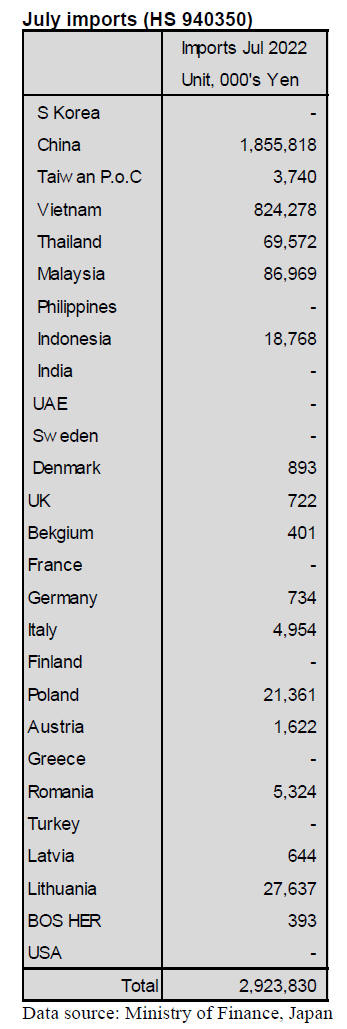
Trade news from the Japan Lumber Reports (JLR)
The Japan Lumber Reports (JLR), a subscription trade
journal published every two weeks in English, is
generously allowing the ITTO Tropical Timber Market
Report to reproduce news on the Japanese market
precisely as it appears in the JLR.
For the JLR report please see:
https://jfpj.jp/japan_lumber_reports/
Cedar logs for China
The weak yen and a fall in freight caused a high
competitiveness of exporting cedar logs to China. A
purchase price of logs is around 10,500 yen, at port per
cbm and this is 100 yen more than last month. A selling
price is USUS$130, C&F per cbm and this is US$10 lower
than last month. However, a payment is in yen so Japanese
companies receive profit. There is an increase in exporting
logs to China because the prices are lower than NZ logs,
which are around US$150, C&F per cbm.
A peak of the prices was US$160, C&F per cbm in March
and the prices started decreasing. On the other hand, the
freight kept increasing until summer. The freight was
US$80,000 to load 2,500 cbms for a ship at the beginning
of this year and the freight increased US$100,000 –
110,000, 2,500 cbms for a ship in August.
The yen started to fall from 115 yen to 144 yen against the
dollar since spring. It is a good opportunity to sell in yen.
The selling prices is US$30 lower than the peak and is
18,720 yen, C&F per cbm. It was 18,400 yen, C&F per
cbm at the peak. The freight dropped suddenly. It is
around US$90,000 recently.
Some reasons are slow economies in the world and
confusions at ports have been solved. If a cbm were
US$36 of the freight US$90,000, it would be 5,184 yen. It
would be nearly 700 yen drop from the peak even though
it was the weak yen. The log prices are increasing.
Demand of cedar logs for lumber and plywood is low but
for biomass fuel, it is lively and the prices are high to
export overseas.
There are 180,000 – 190,000 cbms of cedar log inventory
at ports around Shanghai, China. Once the volume
declined to 160,000 cbms after the lockdown lifted in June
but the volume is growing again because exporting cedar
fences to the U.S.A. is slow.
A NZ log costs around US$150 and a European log costs
around €170. The prices increased slightly. The Chinese
government would work out a monetary policy to grow
economy active. Usually, China imports logs from Japan
at the end of the year through the Chines New Year’s
holiday, so it is important to watch carefully how the
Chinese government would do.
A budget request in 2023
The Ministry of Agriculture, Forestry and Fisheries
announced about its budget request in 2023 to the Ministry
of Finance, Japan on 30th, August.
The budget request is 350.6 billion yen, 17.8% more than
last year to promote supplying domestic logs or lumber
stably and sustainably and to reforesting.
The budget request for public works projects is 231.6
billion yen, 17.4% more than last year and for non-public
works projects is 119 billion yen, 18.4% more than last
year.
The goals are to grow agriculture, forestry and fisheries
business and to succeed local traditions of rural districts to
next generation. There is a big theme to achieve carbon
neutrality. There are several plans such as strengthen in
supply and use of domestic lumber, training people for
forestry business, develop distribution business and
introduce high quality machines and so on. By doing these
plans, the volume of supply and use of domestic logs or
lumber will expand to 42,000,000 cbms by 2030 from
31,000,000 cbms in the year of 2020.
The Ministry of Agriculture, Forestry and Fisheries
will
support introduction of more trucks to transport log and
lumber. Another support is to supply CLT stably with low
costs by standardizing measures of CLT and promote
wooden high rise buildings in populated regions.
Plywood
A movement of domestic softwood plywood is dull after
the prices settled down. A shortage of long plywood is
solved in Western Japan and plywood companies have
enough inventory. Plywood companies start to adjust
production.
An inventory of plywood manufacturers at the end of
August was 111,495 cbms, 11.9% more than July. This
inventory was less than the inventory in May, 2020, which
was 178,998 cbms. A shipment was 223,652 cbms, 11.0%
less than the previous month. This was a low-level
volume. Some plywood companies reduce producing
plywood and will watch the situation carefully. This is a
different situation from usual years.
Trading companies reduce orders for South Sea plywood
due to the increased arrivals and overstocking at ports
since the 2Q. The volume of Malaysian plywood fell
below the previous year’s volume since May. The volume
of Indonesian plywood exceeded the previous year’s result
for 13 months continuously. The inventory is still too
much. Suppliers in South East Asia lowered the prices by
around USUS$40, C&F per cbm, but the import yen costs
are high due to the weak yen. It is difficult to raise the
prices to sell in Japan so it is difficult to place new orders.
The prices of plywood for concrete forming 12mm, 3 x 6
are USUS$860, C&F per cbm in South East Asia and this
is stabilized. The import cost is 2,560 yen, FOB per cbm
as the dollar is 143 yen. This is over 100 yen increasing
from last month. The prices in Japan are 2,400 yen,
delivered per sheet and it is 100 yen higher than the
previous month.
Imported lumber inventory at Tokyo
The inventory of imported lumber at Tokyo port at the end
of August is 210,000 cbms, 7.1% more than the previous
month. This is straight two months increasing. Dull
shipment and steady arrivals of Russian and European
lumber are the reasons of this much inventory.
The volume of lumber from North America is 49,000
cbms, 1,000 cmbs more, from Europe is 67,000 cbms,
6,000 cbms more, from Russia is 52,000 cbms, 6,000
cbms more and from China or other countries are 23,000
cbms, 1,000 cbms more than last month.
Since European lumber arrived to Japan with excess
volume during May, 2021 to March, 2022, which are
eleven months, the volume of 16,000 cbms at the end of
April, 2021 rose to 59,000 cbms at the end of March,
2022. Once the volume declined in April and May, 2022
but it started to rise in June.
Then, the volume at the end of June was 61,000 cbms.
This was for the first time to be high-level volume since
September, 2019.
This situation also occurs on Russian lumber. The volume
in September, 2021 was 19,000 cbms and the volume at
the end of March, 2022 was 37,000 cbms. The volume
decreased in April and May, 2022 and started increasing in
June. The volume at the end of August was very high-level
for the first time in two years.
The prices of imported lumber in overseas were very high
at the 3Q in last year and started to decline until the 1Q in
this year. An invasion in Ukraine by Russia influenced
people to buy a lot of Russian lumber. Then the prices
overseas rose again. As a result, Russian lumber kept
arriving to Japan and the volume of lumber grew. A
movement of lumber in Japan has been dull and a
shipment in July and August was only 59,000 cbms.
The volume in September in this year will be 56,000
cbms, 24.3% less than September, 2021 and in October
will be 50,000 cbms, 26.5% less than October, 2021.
The shipment in September in this year will be 62,000
cbms, 3.1% less than the same month in last year and in
October will be 61,000 cbms, 10.3% less than the same
month in last year. However, it will be difficult to reduce
the inventory in a short time. It will take some time for the
inventory to drop down to proper level of 150,000 cbms or
less.
|